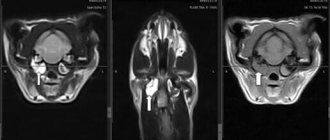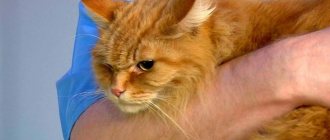Pain is a physiological reaction to certain disturbances in the normal functioning of the body’s vital systems. This is a signal to take action to help the pet. In some cases, feline pain medication should be given immediately.
In the article, in addition to drugs for pain relief, we also look at the causes of pain and give advice in which cases a cat really needs to be given medicine. We do not recommend skipping these sections, but if you want to know only about the best drugs and their prices, then refer to the contents .
Signs of pain
Usually cats tolerate pain patiently, but in some cases it is a signal for an urgent visit to the veterinarian.
Signs that your cat is in pain:
- unusual behavior: excessive activity or lethargy;
- unjustified aggressive reactions;
- lack of appetite;
- desire for solitude;
- uncharacteristic apathy and drowsiness;
- refusal of the litter tray;
- drooling and vomiting;
- cardiopalmus;
- heavy or difficult breathing, shortness of breath.
When is pain medication needed?
Pain syndrome can be acute and chronic. In case of severe injury or cancer, delay in providing assistance to your pet can lead to painful shock and even death.
Injuries most often occur during fights with dogs and other cats, when the animal is hit by a car, when falling out of a window or simply from a height.
Typically, pain in cats is accompanied by:
- Oncological diseases.
- Injuries - superficial extensive wounds and cuts, fractures of the paws and spine, bruises and torn ligaments.
- Postoperative period after surgery.
- Recovery after castration or sterilization.
- Chronic diseases in the acute stage - pancreatitis, cystitis, urolithiasis, others.
- Kidney or stomach colic.
- Disruption of the nervous system.
- Tooth and jaw pain (usually when enamel is destroyed).
Mechanism of action
Further - it’s more interesting: scientists say that the exact mechanism of action of analgin is not fully understood, but it is believed that the drug reduces the synthesis (production) of prostaglandin (active substances produced by the body from fatty acids).
Prostaglandins (fat-like molecules) are “conductors” that influence the formation of platelets - blood cells responsible for coagulation (wound healing), and they are also involved in the biochemical mechanism of transmitting pain sensations to the brain and increasing temperature during inflammatory processes.
Be sure to read:
Dexamethasone for cats: description, what it is needed for, instructions, dosage, contraindications
This means, literally, the following: if a cat injured its leg or had surgery, then after anesthesia with analgin, the wound will heal more slowly.
In addition to suppressing platelet synthesis, prostaglandins affect the respiratory functions of the lungs (spasms or expansion of smooth muscles), gastrointestinal motility (contraction and relaxation, secretion of gastric juice), and uterine contraction.
When administered intramuscularly, the effect on the gastrointestinal mucosa is reduced, and pain relief occurs faster.
Types of veterinary drugs for pain
Cats differ from humans and most other domestic animals in their response to pain medications. The list of approved products that do not have a high toxic effect on your pet is very narrow.
Types of analgesics used in veterinary medicine and allowed for cats:
- Narcotic. Prescribed only under the supervision of a veterinarian in exceptional cases - in case of severe injuries and oncological pathologies. These are Omnopon, Fentanyl, Tramadol, Codeine.
- Non-steroidal anti-inflammatory drugs (NSAIDs). Unlike the first group, they are not addictive and not only relieve pain, but also have a therapeutic effect. In acute attacks they are ineffective. These are Ketonal, Ketofen, Quadrisol, Rimadyl, Meloxicam, Vetalgin.
- Other. Some medications intended for treating humans are also suitable for cats. These are Papaverine in the form of injections, Baralgin, some others as prescribed by a doctor.
Analgin-ultra
Local reactions: with intramuscular injection - infiltrates at the injection site.
Use with caution during pregnancy, especially in the first trimester and in the last 6 weeks.
Contraindicated in cases of severe liver dysfunction.
Contraindicated in cases of severe renal impairment.
Use with caution in children in the first 3 months of life.
Single doses for children aged 2-3 years are 50-100 mg; 4-5 years – 100-200 mg; 6-7 years – 200 mg; 8-14 years – 250-300 mg; frequency of administration – 2-3 times/day.
With long-term use, it is necessary to monitor the peripheral blood picture.
Metamizole sodium is used in combination with pitofenone and fenpiverinium bromide as an analgesic with an antispasmodic effect.
When used simultaneously with analgesics-antipyretics and NSAIDs, mutual enhancement of toxic effects is possible.
READ What cereals can and cannot be given to cats
When used simultaneously with inducers of microsomal liver enzymes, the effectiveness of metamizole sodium may decrease.
When used simultaneously with phenothiazine derivatives, severe hyperthermia is possible; with sedatives, anxiolytics - the analgesic effect of metamizole sodium is enhanced; with tricyclic antidepressants, oral contraceptives, allopurinol - the metabolism of metamizole sodium is disrupted and its toxicity increases; with caffeine – the effect of metamizole sodium is enhanced; with cyclosporine – the concentration of cyclosporine in the blood plasma decreases.
When metamizole sodium is used in combination with pitofenone hydrochloride (has a direct myotropic effect on the smooth muscles of internal organs and causes its relaxation) and with fenpiverinium bromide (m-anticholinergic), their pharmacological action is mutually enhanced, which is accompanied by a decrease in pain, relaxation of smooth muscles and reduction of elevated body temperature.
Table of painkillers approved for cats with approximate dosages
It is recommended to give any painkillers to your pet only as prescribed by a veterinarian and in dosages calculated based on the age, weight, and physiological characteristics of the animal.
Sometimes taking immediate action to relieve a cat's pain is urgent. Approximate dosages are calculated in the table for an average-sized adult animal.
| Drug name | Dosage | Mode of application | Description and price |
| Ketonal | 1 mg per 1 kg of weight, twice a day | Injections | NSAIDs. 10 ampoules of 2 ml - about 250 rubles. |
| Ketofen | 2 mg per 1 kg of weight | In the form of injections or tablets | Wide spectrum of action, not recommended for gastrointestinal diseases. 10 tablets of 5 mg - 500 rub. 20 ml bottle for injections - 1150-1200 rubles. |
| Quadrisol | 1 ml per 10 kg weight | Oral (gel) | A veterinary drug from the NSAID group. Syringe tube 15 ml - no information on cost. |
| Rimadyl 5% | 2 mg per 1 kg of weight, once | Injections | Anti-inflammatory veterinary pain reliever. 20 ml bottle for injections - 2100-2150 rubles. |
| Vetalgin | 1 tablet once or twice a day | Oral (tablets) | A veterinary drug for general use. 10 tablets - 140-170 rubles. |
| Analgivet | 0.05-0.1 ml per 1 kg of weight | Injections | A veterinary drug from the NSAID group. 10 ml - 300 rub. 100 ml - 1200 rub. |
| Dexafort | 0.1-0.2 ml | Injections | Veterinary drug for injuries with swelling. Contraindicated for heart disease. 50 ml bottle for injections - 1000-1100 rubles. |
| Ketoprofen | 2 mg per 1 kg of weight | Injections | A veterinary drug from the NSAID group. 10 ampoules of 2 ml - about 100 rubles. |
What tablets can be given to a cat?
Below is a list of medications that are approved for use in animals.
What tablets can be given to a cat:
- Analgin. This remedy is given not only for pain relief, but also as an antipyretic for cats with fever. It should be given in an amount of 0.5 g per cat weighing approximately 5 kg. Drugs such as Paracetamol and Aspirin are not given to animals. They contain a large amount of acid, which can be harmful to the animal's body.
- Antihistamines for children in drops help relieve allergies and swelling. This is the drug Zodak, as well as Eden . Administered in an amount two times less than in the instructions for the smallest children and newborns.
Swelling can be removed using ordinary magnesia in solution. It is necessary to dissolve 30 ml of the product in 1000 ml of warm water. A tampon is soaked in this product and applied to the swelling. Miramistin and Chlorhexidine solutions can be used to treat cats. This is usually done during the treatment of bites, wounds, and cuts. Albucid eye drops are used to treat conjunctivitis and eye inflammation.
Medicine
Mr. Cat recommends: alternative methods for relieving a cat of pain
In addition to medications, in modern veterinary medicine there are alternative methods of pain relief.
- Magnetic therapy. It is a method of pain relief widely practiced in traditional medicine. Veterinary clinics usually have special devices (“harnesses”) for attaching metal plates to the body of a sick animal.
- Acupuncture is good for relieving aching pain that usually accompanies chronic diseases.
- Homeopathic remedies. An example of a herbal remedy widely used in veterinary medicine is Travmatin. It is often prescribed before and after sterilization of cats.
- Compresses, heating pads, infrared emitters. They help well in the treatment of chronic pain of a non-inflammatory nature. Contraindicated for any inflammation or if the etiology is not clear.
- Anti-pain massage. It helps well in the complex of rehabilitation therapy after fractures and sprains for pain relief.
Traditional and alternative methods
If your pet is suffering from severe pain, you should not give preference to traditional methods of therapy. They are most often ineffective. Alternative methods of pain relief can be used only in cases of moderate severity.
In some cases, massage can relieve pain
It is very important to take the animal to an appointment with a veterinarian at the first sign of pain, who will determine the cause of the illness and prescribe the necessary medications. For mild manifestations of pain, an infusion prepared with chamomile, mint and lemon balm can help. The folk remedy helps to relax your pet and relieve pain.
To alleviate the animal’s suffering, you can use alternative methods of relieving pain, namely:
- Homeopathic remedies such as Traumatin, Traumeel. Medicines are made on a plant basis. They can only relieve mild pain. The duration of therapy exceeds 7 days. Quite often, Travmatin is used after castration of cats to relieve discomfort that causes anxiety to the animal.
- Manual therapy - massage. The procedures help improve blood circulation, relieve swelling, muscle spasms, and pain that arise from injuries.
- Compresses and heating pads used in the treatment of chronic diseases accompanied by pain and inflammation. With their help, you can effectively eliminate swelling.
- Acupuncture - acupuncture. The procedure helps relieve mild to moderate pain.
- Magnetotherapy, which helps eliminate pain and inflammation in the body.
Before deciding which way to relieve pain in a cat, it is necessary to identify the cause against which the syndrome developed.
What drugs are prohibited for cats?
There are a number of “human” drugs that are strictly prohibited for cats. Of the painkillers, this is Ketorol, which is often confused with the approved Ketonal. The first causes severe stomach bleeding in the cat and leads to the death of the pet.
You should not give them, due to their high toxicity for cats, although they will not cause such severe consequences:
- Aspirin;
- Paracetamol;
- Ibuprofen (Nurofen);
- Theraflu;
- Analgin;
- No-Shpa.
What not to give to cats
Indications for the use of pain medications for cats
Cats need pain relief in the following cases:
- cancer;
- previous surgery;
- dental treatment;
- fractures and ligament ruptures;
- otitis media;
- falling from a height;
- castration and sterilization;
- diseases of the nervous system;
- kidney disease;
- urolithiasis;
- inflammatory process of internal organs.
Pain reliever for cats
Painkillers are divided into two types:
- with the presence of a narcotic substance in the composition;
- non-narcotic.
The first group belongs to the opioid category. The main active ingredient of the drug is morphine. Medicines act as a blocker and can provide pain relief for the most severe injuries and illnesses.
The second group includes non-steroidal anti-inflammatory drugs that can block moderate pain. In addition to eliminating painful sensations, their root cause is eliminated. Non-narcotic medications are not addictive. The drugs are actively used for diseases of the motor system.
A veterinarian who can identify the cause of the disease should select medications to relieve pain. The thoughtless use of drugs will only aggravate the situation and cause additional suffering to the pet.
The following symptoms and behavior patterns may indicate the need for urgent use of pain medication:
- increased/decreased (non-standard) degree of activity;
- desire to hide from a person;
- aggressiveness;
- loss of appetite;
- increased salivation;
- rapid breathing and pulse;
- stiffness of movements.
How to give a pill to a cat and give an injection
All injections that the owner can give to the animal himself at home are usually done subcutaneously at the withers.
To do this, you need to fix the cat on a hard surface (with the help of a second person), pull up the skin at the withers and insert the syringe needle under the skin, the drug is infused slowly. Gently rub the injection site.
The tablet can be given using a special device, crushed and inserted into the oral cavity from a syringe without a needle with water or liquid food.
You can also take the animal by the scruff of the neck, secure it well on the floor, open its mouth and place the tablet on the root of the tongue. Then hold the mouth tightly with one hand, and with the other hand, carefully move it several times along the animal’s neck in order to evoke a swallowing reflex.
Also read articles about how to properly give injections to a cat intramuscularly and subcutaneously, and how to feed a pill to an animal.
Can cats be given pills?
In general, it is initially better to ask your veterinarian if there is another option for the substance. That is, syrup, suppositories or injections. The most common tablet option is deworming medicine.
Can cats be given tablets:
- The fact is that cats have a negative attitude towards taking pills and often spit them out. This is not due to the pet’s bad character or bad manners, but to the structural features of the throat and oral cavity. Most cats resist in every possible way when the owner tries to put a tablet in his mouth, spitting it out.
- It is best to give the medicine in its pure form, that is, try to get the cat to swallow the whole tablet. This is difficult, especially if it is large.
- Can I mix the tablets with food, water, or wash them into powder? It is best to clarify such options for using tablets with a veterinarian. Some medications should never be mixed with liquid or food, so you will have to force your pet to swallow the medicine. And this is quite difficult to do. There is no guarantee that your cat will swallow the pill if you put it in its mouth.
Syringe
Can a cat be given Analgin?
Veterinarians do not give a clear answer to this question. Some experts prescribe an injection of Analgin-Diphenhydramine to reduce high fever, and the animal tolerates it normally.
In other cases, an unfavorable reaction to the drug is noted. Drooling, vomiting, diarrhea, convulsions, even death. Presumably, such side effects are caused by the active substance – Metamizole (Noramidopyrine). This is a non-steroidal anti-inflammatory drug that has special antispasmodic properties, characterized by increased salivation (salivation).
The use of Analgin, and indeed any “human” antispasmodics, is contraindicated in any animals due to its toxic effect on the bone marrow, kidneys and liver. By the way, Analgin is also excluded from human medicine; it is replaced with antispasmodics of new generations.
But I would like to note that this is only one of the opinions of veterinarians. Others insist that a one-time administration of Analgin will not cause harm. At the same time, everyone agrees that Aspirin, Paracetamol and any other “human” antipyretics are deadly for cats.
From the author. I would also like to note that in our nursery we have never taken risks and never used human antispasmodics. In case of serious injuries, we turned to competent surgeons; they have a large arsenal of veterinary drugs.
Painkillers for cats (What not to give)
A new family member has appeared in your home. It completely changed your way of life, conditionally dividing it into “before” and “after”. This is an absolutely independent animal in its essence, it delivers a lot of positive emotions and has powerful energy.
No wonder cats are credited with magical properties. It is believed that they can communicate with the other world, for this they were revered in Egypt and recognized as sacred. But along with the joy of communication, these cute animals bring with their appearance care and concern for them.
How can you tell if something is wrong with your pet?
Signs and symptoms
We know the behavior of our pets well; it is very changeable, from wild delight to absolutely sleepy indifference. However, this does not make us worry about what can be done about their temperament. But at some point the pet’s behavior looks unusual
- The nose is dry, the cat becomes inactive, lethargic, and her temperature has risen.
- Refuses to eat, loses weight.
- From calm and affectionate it turns into aggressive.
- Hair falls out or bald spots appear.
- Vomiting with diarrhea begins.
This is a reason to sound the alarm and take your pet to the vet. There are very unexpected cases: a cat hurts itself, sprains a paw, or has a high fever; urgently, something needs to be done. The veterinary clinic is far away and the doctor’s help will not come soon, the pet is feeling bad and we are frantically looking for ways to help him.
But the painkillers that a person takes will not always benefit the cat, and there have been cases where the exact opposite is true. The first thing that comes to mind is to give analgin. How safe is it?
There is no clear opinion. The drug does not cure the disease, but brings only temporary relief, relieves pain, but the cause remains. It needs to be identified urgently and only a specialist can do this.
Analgin is produced not only for people, it is also for animals, it comes in the form of tablets, powder or ampoules. It has a bitter taste, which makes it difficult to use; your pet is unlikely to be persuaded to take it. But that's not the worst thing.
Analgin contains the substance metamizole sodium, which is what is dangerous.
The drug must be used very carefully in case of injuries, the blood vessels are already damaged, and analgin damages blood cells and liver cells, it dissolves well and is easily absorbed, therefore a high concentration of the substance is created in the blood, which can cause toxic anemia (lethargy, vomiting, oral mucosa pale color). It also affects the bone marrow; you may notice disorientation and disturbances in the vestibular apparatus in your pet.
In cats, the liver does not have two enzymes that play the main role in processing analgin; it takes the form of a toxic metabolite, partially excreted, but not enough.
For an adult cat, the dose of analgin should not exceed 1/6 of the tablet.
It is strictly contraindicated for kittens, the baby will not cope with even a small dose, the reaction is difficult to predict, it can even be lethal.
To relieve high fever (40 and above), the veterinarian may prescribe injections of analgin along with diphenhydramine, and the dose of the drugs is calculated taking into account the weight and age of your pet.
On average, this is 0.5 ml/kg of analgin and 0.1 ml/kg of diphenhydramine.
Diphenhydramine is an antihistamine and relieves allergy symptoms (swelling of the animal’s mucous membranes, pulmonary edema) that are caused by analgin, which makes the cat breathe with difficulty, and the lack of oxygen that enriches the blood worsens its condition.
Therefore, it is very important that our patient is currently under the supervision of a doctor. Each cat, like a person, requires an individual approach during treatment, and only a specialist can determine the severity of the animal’s condition.
Self-medication is not encouraged; your excessive care may not help, but harm your pet. Even among veterinary doctors there is no complete agreement on whether analgin should be used or not.
Is it possible to give cats analgin? Each of you will decide for yourself, taking into account that it destroys liver and blood cells, affects the bone marrow, but at the same time reduces the temperature. Reduces hemoglobin in the blood, causing anemia, but relieves inflammation well.
Considered toxic to cats, but only in overdose. And most importantly, you need to understand in time that your furry is sick and needs help. Pay attention to this and be sure to show it to your doctor. And he will delight you for a long time with his cheerful, playful disposition. It will warm you with its warmth and soothe you with its purring.
Painkillers for cats are an important component of every cat owner’s first aid kit. Cats experience pain, but cannot communicate this to their owner.
It is the owner's duty to anticipate when the animal will encounter pain and to understand that the animal is feeling pain.{amp}lt;p{amp}gt;
Of course, it is unacceptable to give a pain pill as soon as you think the animal is suffering.
It is important to make sure that this step is necessary and to determine the source of pain. The decision to prescribe analgesics must be made by a veterinarian.
In this article we will tell you how to understand that an animal needs analgesics, we will tell you which painkillers of professional and traditional medicine to choose.
Painkillers for cats are prescribed only as part of complex therapy. Painkillers themselves do not cure anything, they only relieve pain. First of all, it is necessary to determine the cause of the animal’s suffering and prescribe treatment for the underlying disease.
READ Endometritis disease in cats, causes of its occurrence, complications and treatment
The second thing that owners should remember is that all analgesics are very toxic, uncontrolled use of this group of drugs is unacceptable. They are given to pets only as prescribed by a doctor, in the specified dosages and periods.
There are a number of diseases that are accompanied by acute pain. Suffering worsens the course of the underlying disease, has a detrimental effect on the animal’s nervous system, and disrupts the functioning of body systems. Severe pain causes a shock reaction and is fatal.
Pathologies with severe pain:
- malignant neoplasms;
- injuries: fractures, bruises, concussion, ligament rupture, joint dislocation, rupture of internal organs;
- gastric volvulus, peritonitis;
- progressive tooth decay;
- urolithiasis, renal failure;
- inflammation: otitis media, endometritis, pancreatitis, etc.;
- renal and hepatic colic;
- gingivitis;
- volvulus, constipation, intestinal obstruction;
- condition after surgery;
- CNS diseases.
Cats are secretive animals with a high pain threshold that openly express their torment only on the verge of painful shock. The owner must know the signs by which a cat’s suffering can be determined in order to have time to help it.
Symptoms of pain syndrome:
- Changes in the animal’s behavior: a sharp decrease or increase in activity.
- Unjustified aggression.
- Avoiding contact with humans and other pets.
- Loss of interest in food. Refusal of favorite treats.
- Attempts to adopt atypical body postures: arching the back, head in the corner.
- Apathy, drowsiness. Sleeping in unusual places. The cat is looking for a secluded corner.
- Refusal to use the litter box.
- Cardiopalmus.
- Profuse salivation.
- Heavy rapid breathing. Dyspnea.
A veterinarian should prescribe pain medication for your cat. Only a specialist can assess the need for analgesic therapy and select the type, brand and dosage of the medication. When prescribing, the biometric characteristics of the pet (weight, age, gender), its health and physiological condition must be taken into account.
In cat veterinary medicine, a limited list of drugs is used.
Most analgesics used to treat humans, dogs, and large pets are toxic to cats.
Types of drugs used in cats:
- Opioids. Narcotic drugs.
- Non-steroidal anti-inflammatory drugs.
- Local anesthetics.
- Alpha2-adrenergic agonists (alpha2-adrenergic receptor agonists).
- NMDA receptor antagonists.
- Anticonvulsants.
| Film-coated tablets | 1 tab. |
| metamizole sodium | 500 mg |
5 pieces. – contour cell packaging (1) – cardboard packs. 10 pcs. – blister contour packages (1) – cardboard packs.
20 pcs. – blister contour packages (1) – cardboard packs.
Analgesic-antipyretic. It is a derivative of pyrazolone. It has an analgesic, antipyretic and anti-inflammatory effect, the mechanism of which is associated with inhibition of prostaglandin synthesis.
After oral administration, metamizole sodium is rapidly hydrolyzed in gastric juice to form the active metabolite 4-methyl-amino-antipyrine, which, after absorption, is metabolized into 4-formyl-amino-antipyrine and other metabolites. After intravenous administration, metamizole sodium quickly becomes inaccessible for determination.
Pain syndrome of various origins (renal and biliary colic, neuralgia, myalgia; with injuries, burns, after operations; headache, toothache, menalgia). Fever in infectious and inflammatory diseases.
Adults are prescribed 250-500 mg 2-3 times a day orally or rectally. The maximum single dose is 1 g, daily dose is 3 g. Single doses for children aged 2-3 years are 50-100 mg; 4-5 years – 100-200 mg; 6-7 years – 200 mg; 8-14 years – 250-300 mg; frequency of administration – 2-3 times/day.
IM or IV slowly for adults – 250-500 mg 2-3 times a day. The maximum single dose is 1 g, daily dose is 2 g. In children, it is used parenterally at a dose of 50-100 mg per 10 kg of body weight.
Allergic reactions: skin rash, Quincke's edema; rarely – anaphylactic shock.











